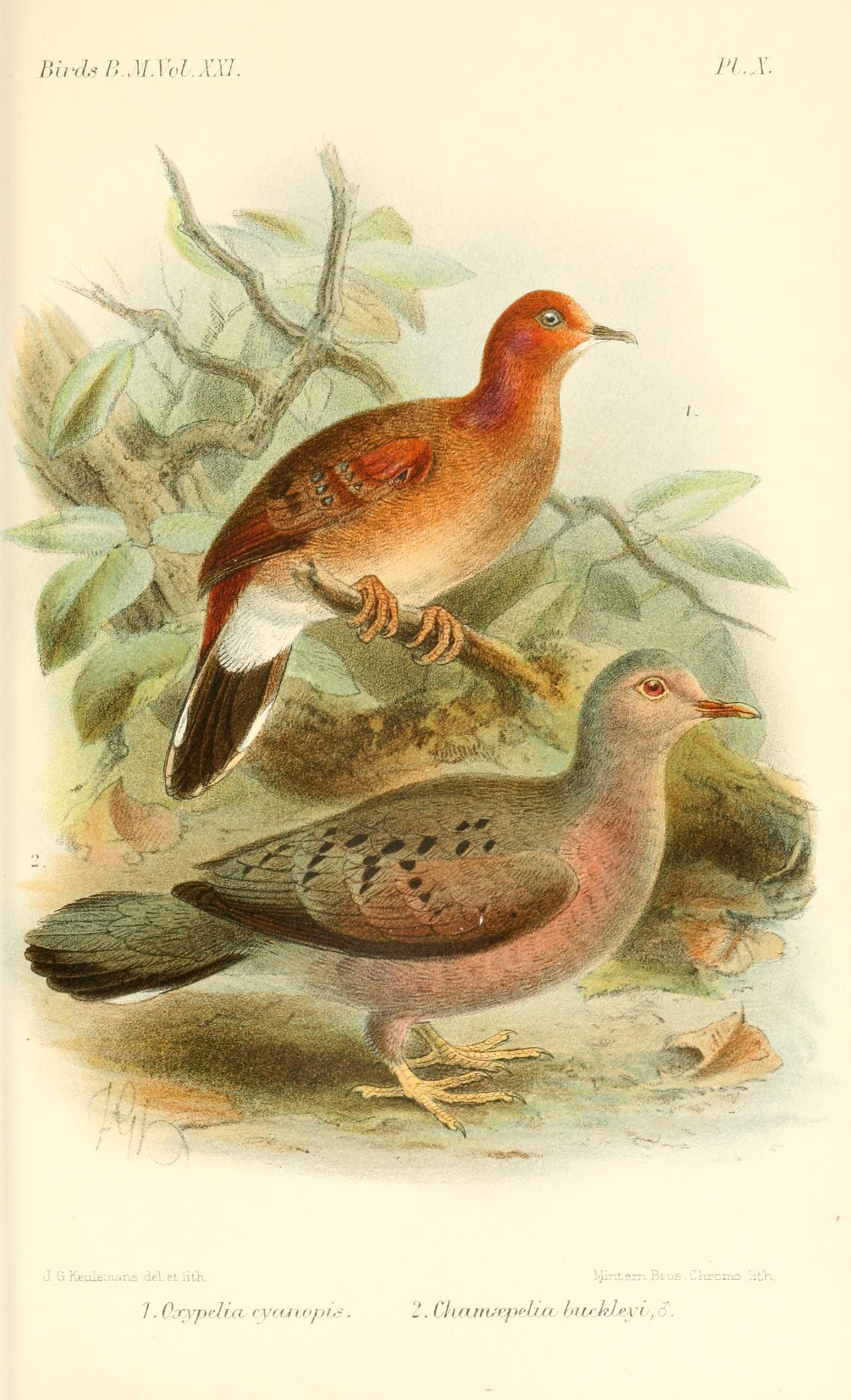An Incredibly Rare Bird Has Been Rediscovered in Brazil
The blue-eyed ground dove has only been spotted on a handful of occasions—now, one researcher photographed it for the first time.

An 1893 illustration of the blue-eyed ground dove. Until recently, the bird had never been photographed. (Illustration: John Gerrard Keulemans/Public Domain)
In 2015, the IUCN Red List, which assesses the conservation status of animals and plants worldwide, listed 218 bird species as critically endangered. One of the rarest species on the list is the blue-eyed ground dove; the species’ population is so small that it has only been observed a handful of times, most recently in 2007. But this week, a team of Brazilian scientists are reporting that they have not only observed the doves in the wild; they’ve found a population in an area the birds have never been proven to inhabit before.
No one knows very much about the blue-eyed ground dove. It has blue eyes (and blue spots) and it spends most of its time on the ground, as its name suggests. BirdLife International provides a fairly detailed physical description and….not much else. We’re not even sure what this bird sounds like. And let’s be clear: that’s pretty unusual. Bird enthusiasts and ornithologists meticulously document bird species, creating databases like the Internet Bird Collection, which provides photos, videos, and and audio recordings for the majority of birds existing today.
Of course, when the species population is somewhere between 50 and 249 individuals, it’s not so surprising that they’d be a little challenging to find. Until this week, only three populations of blue-eyed ground doves had been observed in the vast Cerrado region of Brazil, where the birds are endemic. Of those three populations—located in the Brazilian states Mato Grasso and Mato Grasso do Sul two are considered possibly extinct. Historically, specimens had also been found in Goiás and for many years it was assumed that 75-year-old reports of sightings in Minas Gerais were erroneous; now, however, those historical reports appear to have been accurate.

A distribution map of the blue-eyed ground dove based on IUCN data. The populations in orange are extant, while the populations in red are possibly extinct. (Illustration: Netzach/CC BY-SA-4.0)
Speaking with Brazilian newspaper Estadão, researchers from the Observatório de Aves at the Instituto Butantan and SAVE Brazil announced the rediscovery of the blue-eyed ground dove and explained how they stumbled upon the new population. In June 2015, ornithologist Rafael Bessa was undertaking an expedition in the Cerrado when he noted an unfamiliar bird call. The next day, Bessa told Estadão (per Google Translate):
I returned to the place and I could recreate this vocalization with my microphone. I reproduced the sound and the bird landed on a flowering bush, coming towards me. I photographed the animal, and when I looked at the picture carefully, I saw that I had recorded something unusual. My legs started shaking.
Not only had Bessa managed to spot the incredibly rare blue-eyed ground dove, he also took the first photograph and first recorded vocalization of the bird, which until now had only been presented to the public through taxidermied specimens. Immediately, he contacted researcher Luciano Lima, who confirmed his findings, and the pair reached out to SAVE Brazil, which helped the ornithologists form a research team with scientists from SAVE Brazil and Louisiana State University’s Museum of Natural Science.
The research team continues to observe the site where the birds were first discovered, and has since documented 12 blue-eyed ground doves. While they work to gather more information about the species for the scientific record, they’re also developing a conservation plan to ensure the population’s long-term survival.
Given the species’ critically endangered status, developing a conservation plan is hugely important. As Bessa explained to Estadão, the blue-eyed ground dove was incredibly rare even before the Cerrado became subject to what the Cornell University Lab of Ornithology refers to as “massive and and more or less uncontrolled habitat modification” to support large industrial agriculture activities. According to BirdLife International, by 1993 two-thirds of the Cerrado had been heavily or moderately altered by grazing, invasive grasses, annual burnings, and agriculture conversion. SAVE Brazil’s Warner Nogueria, a member of the research team, believes that the the blue-eyed ground dove’s natural habitat is a very specific “micro-habitat” of the Cerrado, and may be as rare as the bird itself.
The blue-eyed ground dove’s small population and rare habitat has inspired the research team to raise concerns that a new constitutional amendment designed to relax environmental licensing regulations for infrastructure projects could wipe out the species and others like it in the Cerrado. The scientists believe that the story of the blue-eyed ground dove is an example of how even small projects could devastate entire species. According to Lima:
What we call the Cerrado is a set of different ecosystems. Therefore, an animal in a Cerrado region does not necessarily exist throughout the biome. So if we destroy a piece of forest in a specific location, we may be leading to endangered species that only live there.
As they continue their work, the research team hopes they will motivate additional exploration of Brazilian biodiversity, thereby increasing the quality of life for all species that call Brazil home.


















Follow us on Twitter to get the latest on the world's hidden wonders.
Like us on Facebook to get the latest on the world's hidden wonders.
Follow us on Twitter Like us on Facebook